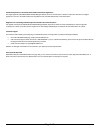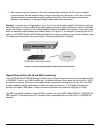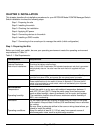
Page 9 of 9
CHAPTER 2: PHYSICAL DESCRIPTION
This chapter describes the hardware features of the NETGEAR Model FSM726 Managed Switch. Topics
include:
Front and back panels
10/100 Mbps auto-sensing RJ-45 ports
Gigabit Ethernet Ports (RJ-45 and GBIC module bay)
LED descriptions
Console port
Reset Button
Front and Back Panels
Figures 2-1 and 2-2 show the key components on the front and back panels of the NETGEAR Model
FSM726 Managed Switch
The front panel contains LEDs, RJ-45 jacks, GBIC module bays, and a console port. The back panel has a
standard AC power receptacle for accommodating the supplied power cord.
Figure 2-1. Front Panel of the FSM726 Managed Switch
Figure 2-2. Back Panel of the FSM726 Managed Switch
10/100 Mbps RJ-45 Ports
As Figures 2-1 and 2-3 shows, the FSM726 Managed Switch has 24 10/100 Mbps RJ-45 ports. These
ports are auto-sensing 10/100 Mbps ports: When you insert a cable into an RJ-45 port, the switch
automatically ascertains the maximum speed (10 or 100 Mbps) and duplex mode (half- or full-duplex) of
the attached device. The 10/100 Mbps ports support only unshielded twisted-pair (UTP) cable terminated
with an 8-pin RJ-45 plug.
To simplify the procedure for attaching devices, all RJ-45 ports support Auto Uplink. This technology lets
you attach devices to the RJ-45 ports using either straight-through or crossover cables. When you insert a
cable into the switch’s RJ-45 port, the switch automatically:
• Senses whether the cable is a straight-through or crossover cable, and
• Determines whether the link to the attached device requires a “normal” connection (such as when
connecting the port to a PC) or an “uplink” connection (such as when connecting the port to a router,
switch, or hub).


















